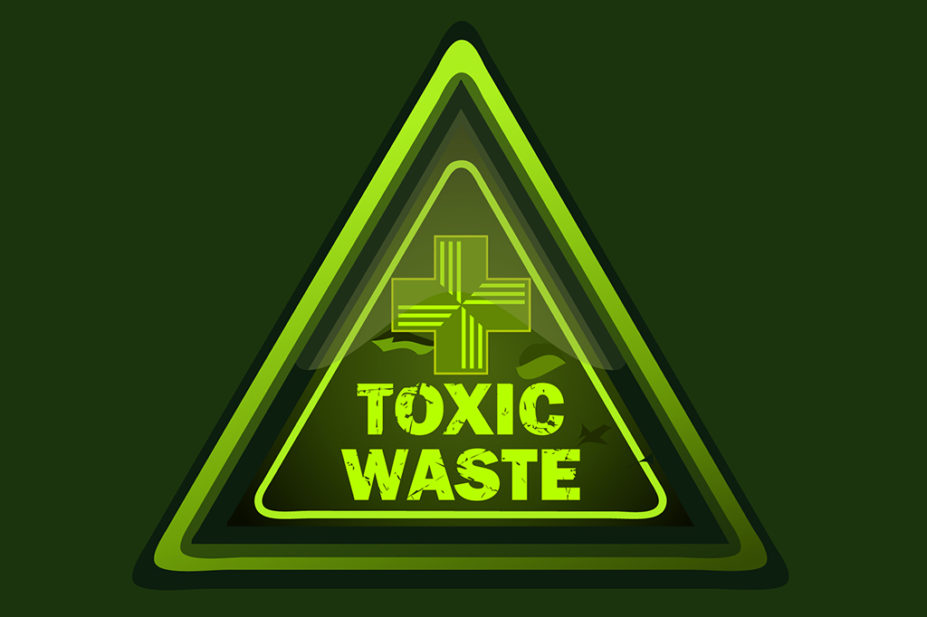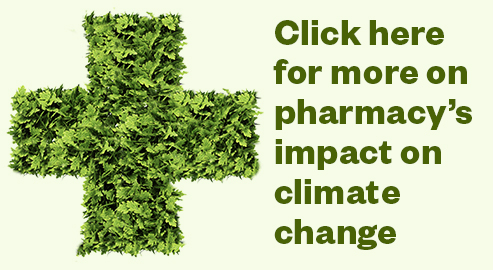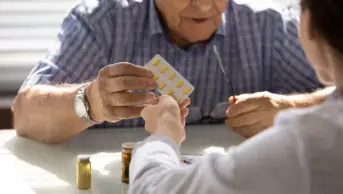
Mclean/Shutterstock.com
Time is running out.
Between 2030 and 2050, an extra 250,000 deaths per year are expected to occur as a direct result of climate change-related effects on fundamentals for good health: food supplies, clean drinking water and air free from harmful levels of pollution[1].
As healthcare professionals, we should recognise the way in which global healthcare systems contribute significantly to climate change. Figures suggest that 4.4% of the net CO2 emissions originate from healthcare or healthcare-related activities, including the pharmaceutical industry, making healthcare a larger net contributor towards climate change than either shipping or aviation[2].
In the UK, the NHS contributes 5.4% of net national CO2 emissions[3], and while 2020 will be remembered for the COVID-19 pandemic, it was also the year that the NHS became the world’s first healthcare system to make a commitment to become carbon neutral[4]. In October 2020, the report ‘Delivering a ‘Net Zero’ National Health Service’ detailed the NHS’s response to the climate emergency and gave the concrete actions it would undertake to reduce the negative impact of healthcare in the UK.
Around 25% of the NHS’s carbon footprint comes from medicines, so it’s clear that pharmacy staff have a role in addressing environmental concern. Initiatives to target particularly problematic agents, such as inhalers and anaesthetic gases, are already underway, and are likely to yield significant CO2 reductions.
However, these are not the only problematic healthcare products: chemotherapy is another area that significantly contributes to our changing natural environment and climate change. In the UK, more than 100,000 patients per year receive chemotherapy treatment across the healthcare systems, and 1 in 2 people are now expected to present with a malignant disease over the course of their lifetime[5]. It is clear, therefore, that treatments must move towards more sustainable models to reduce the long-term environmental impact.
An effort to reduce the environmental impact of cancer treatments will be threefold: reducing environmental exposure; incentivising a greener pharmaceutical industry; and arming pharmacists with the knowledge to practise more sustainably.
Improper disposal of unused medicines and contamination from manufacturing facilities both provide significant contributions to the net total environmental exposure
Reducing environmental exposure
For the past 50 years, anticancer medicines have been important tools in our armoury, but their use in not without risk: there is evidence that these pharmaceutical agents are entering the natural environment. Several studies have identified traces of cytotoxic cancer treatments in samples taken from rivers and sea water in several countries[6,7], including the UK[8].
The impact of these chemicals in the natural environment — either through disposal of chemotherapy waste through incorrect waste management or excretion from patients following administration — is not yet fully characterised, but several studies have identified effects on aquatic life. For example, the CYTOTHREAT study described significant increase in DNA damage and decrease in reproductive potential of crustaceans following exposure to the anticancer drugs etoposide, cisplatin, 5-fluorouracil and imatinib at concentrations that have been documented in environmental surveys[6]. This is in keeping with the results of other high-profile studies that have identified the impact of pharmaceutical waste on wildlife; documented effects include the feminisation of male fish embryos following environmental exposure to hormonal contraception[9].
To reduce the impact that pharmaceutical waste has on the environment, it is important to identify and address potential points of exposure. By far the most significant point is the excretion of medicines and/or medicine metabolites by patients following administration of doses; however, disposal of unused medicines via improper waste management processes, and direct contamination from manufacturing facilities, both provide significant contributions to the net total environmental exposure. Improvements in water and sewage treatment techniques (to effectively remove pharmaceutical waste contamination) represent a potential solution to reduce environmental exposure and have demonstrated promise in studies[10]. However, these treatments come at significant cost and are energy-intensive processes, which are likely to increase the financial impact to governments and consumers and increase CO2 emissions if the energy to fuel these improvements are not sourced from renewable sources[10]. The potential financial outlay involved in implementing these water and sewage treatments has prompted calls from the ChemTrust — a charity that aims to prevent synthetic chemicals from causing long-term damage to wildlife and humans — and the European Federation of National Associations of Water Services (EurEau) to adopt a ‘polluter pays’ strategy, where the pharmaceutical industry becomes liable for financing the necessary improvements[11,12].
Another important part of resolving this issue is removing the potential for pharmaceutical agents to enter the environment at source during the manufacturing process. While this principle is well established in the manufacturing processes of facilities based in post-industrial nations where it is enforced through monitoring by regulatory agencies, it is less well defined in developing world countries, where several studies have identified concerning levels of pharmaceutical agents in water samples taken immediately downstream from production facilities[7]. Outside of pharmaceutical industry manufacturing, hospital pharmacy aseptic production facilities also have a responsibility to reduce the amount of pharmaceutical waste entering the environment by continuing to engage with appropriate waste management processes.
Incentivising ‘green pharmacy’
These approaches are easier said than done. To promote widespread engagement with environmentally sustainable practices, executive regulatory agencies must set policies that promote ‘green pharmacy’[13].
In the UK, the Medicines and Healthcare products Regulatory Agency (MHRA) has implemented a mandatory assessment of risks posed to the environment by all new medical products applying for a licence following the Human Medicines Regulations 2012. The European Medicines Agency has adopted a similar approach, as detailed in the guideline on the environmental risk assessment of medicinal products for human use.
But these policies have little power — while they recognise the impact that pharmaceuticals have on the environment, neither environmental risk assessment serves as a potential barrier to products receiving a licence. Nor do they confer any legal authority to enforce financial leverage on pharmaceutical manufacturers to fund any updates to the infrastructure of the water and sewage treatments, which could increase their efficiency in removing pharmaceutical contamination[14]. This represents a clear area where practice by regulatory agencies can be strengthened to enforce sustainable practice within the pharmaceutical industry and reduce environmental exposure of chemotherapy agents, alongside other pharmaceutical agents.
Regulatory agencies need a new approach — one that strengthens the current environmental risk assessment process to make product licensing contingent on either an agent having an inherent low environmental risk potential; or, more likely, on manufacturers funding the implementation of water treatments that reduce environmental exposure[14]. In the UK, this principle could be extended beyond the licensing process and be included as part of the assessment criteria for the National Institute for Health and Care Excellence’s technology appraisal — this would provide a second layer of assurance and further promote ‘green pharmacy’.
For products that have already received a product licence, assessment of its historical impact will be a more challenging process. Many of these chemotherapy agents have been in use for decades and are now produced by a range of generic manufacturers, which raises questions around collective culpability of the pharmaceutical industry as a whole, rather than focusing on individual companies. The complexity of this issue, and how to successfully resolve it, requires input from all parties involved working together in collaboration to meet the challenge, under the supervision of government bodies such as the MHRA and the Environment Agency.
Pharmacy will have a significant role to play in reducing the risks that these agents pose
Educating pharmacists
This effort will also require pharmacists. With our increasing understanding of the impact of pharmaceuticals on ecosystems, pharmacy will have a significant role to play in reducing the risks that these agents pose. To enable pharmacists to effectively engage with the issue, the profession is likely to require a new set of training and education resources. This education could be incorporated into existing educational structure: inclusion of green pharmacy principles into undergraduate courses may serve as one route to increase awareness.
Pharmacists who also provide this information to other healthcare professionals and the wider public may also help to influence medicine-taking behaviours. This kind of approach has already been established in Sweden, where pharmaceutical agents are graded based on their potential environmental impact and prescribers are encouraged to take this into account when making treatment decisions[15]. This information is also made freely available to the public with the belief that market forces may influence medicine-taking behaviour towards agents, which have a lower impact on the environment and thereby promote greater industry engagement.
Pharmacy at the forefront
Through limited existing studies, we know that cancer treatments are already affecting marine life, but these studies acknowledge that the wider cocktail effect of all pharmaceutical agents combined is yet to be taken into account. This must change.
International pharmaceutical regulators must take enforce strategies that reduce environmental exposure, and work with the pharmaceutical industry to implement change. The healthcare system must also take responsibility for its impact on the environment, and aim to reduce, offset or eliminate it.
It’s in the name — ‘green pharmacy’ — pharmacy must act at the forefront of these measures.
Andrew Walker, senior haematology/oncology pharmacist, The Rotherham NHS Trust; Suhani Ghiya, senior haematology/oncology pharmacist, The Rotherham NHS Trust
Read more about climate change and pharmacy sustainability on our ‘Green Pharmacy’ page. We would welcome any submissions in this area, if you would like to write about this topic then please get in touch: editor@pharmaceutical-journal.com
- 1Climate change. World Health Organization. https://www.who.int/health-topics/climate-change#tab=tab_1 (accessed Jun 2021).
- 2International comparison of health care carbon footprints. IOP Science. 2019.https://iopscience.iop.org/article/10.1088/1748-9326/ab19e1 (accessed Jun 2021).
- 3Healthcare’s climate footprint. ARUP. 2019.https://www.arup.com/perspectives/publications/research/section/healthcares-climate-footprint (accessed Jun 2021).
- 4Delivering a net zero national health service. NHS England. 2020.https://www.england.nhs.uk/greenernhs/wp-content/uploads/sites/51/2020/10/delivering-a-net-zero-national-health-service.pdf (accessed Sep 2021).
- 5Cancer statistics. Cancer Research UK. https://www.cancerresearchuk.org/health-professional/cancer-statistics/treatment (accessed Sep 2021).
- 6Fate and effects of cytostatic pharmaceuticals in the environment and the identification of biomarkers for and improved risk assessment on environmental exposure. European Commission. https://cordis.europa.eu/project/id/265264/reporting (accessed Sep 2021).
- 7Carlsson G, Örn S, Larsson DGJoakim. EFFLUENT FROM BULK DRUG PRODUCTION IS TOXIC TO AQUATIC VERTEBRATES. Environ Toxicol Chem 2009;28:2656. doi:10.1897/08-524.1
- 8Kay P, Hughes SR, Ault JR, et al. Widespread, routine occurrence of pharmaceuticals in sewage effluent, combined sewer overflows and receiving waters. Environmental Pollution 2017;220:1447–55. doi:10.1016/j.envpol.2016.10.087
- 9Gross-Sorokin MY, Roast SD, Brighty GC. Assessment of Feminization of Male Fish in English Rivers by the Environment Agency of England and Wales. Environmental Health Perspectives 2006;114:147–51. doi:10.1289/ehp.8068
- 10Angeles LF, Mullen RA, Huang IJ, et al. Assessing pharmaceutical removal and reduction in toxicity provided by advanced wastewater treatment systems. Environ Sci: Water Res Technol 2020;6:62–77. doi:10.1039/c9ew00559e
- 11Pharmaceuticals in the environment: a growing threat to our tap water and wildlife. CHEMTrust. https://chemtrust.org/wp-content/uploads/CHEM-Trust-Pharma-Dec14.pdf (accessed Jun 2021).
- 12Pharmaceuticals in the Environment: OECD report . EurEau. https://www.eureau.org/resources/news/379-pharmaceuticals-in-the-environment-oecd-report (accessed Jun 2021).
- 13Toma A, Crişan O. Green Pharmacy – A Narrative Review. Medicine and Pharmacy Reports 2018;91:391–8. doi:10.15386/cjmed-1129
- 14Communication from the Commission to the European Commissio to the Council and the European Economic and Social CommitteeE . European Commission. https://ec.europa.eu/environment/water/water-dangersub/pdf/strategic_approach_pharmaceuticals_env.PDF (accessed Jun 2021).
- 15Wennmalm Å, Gunnarsson B. Pharmaceutical management through environmental product labeling in Sweden. Environment International 2009;35:775–7. doi:10.1016/j.envint.2008.12.008


